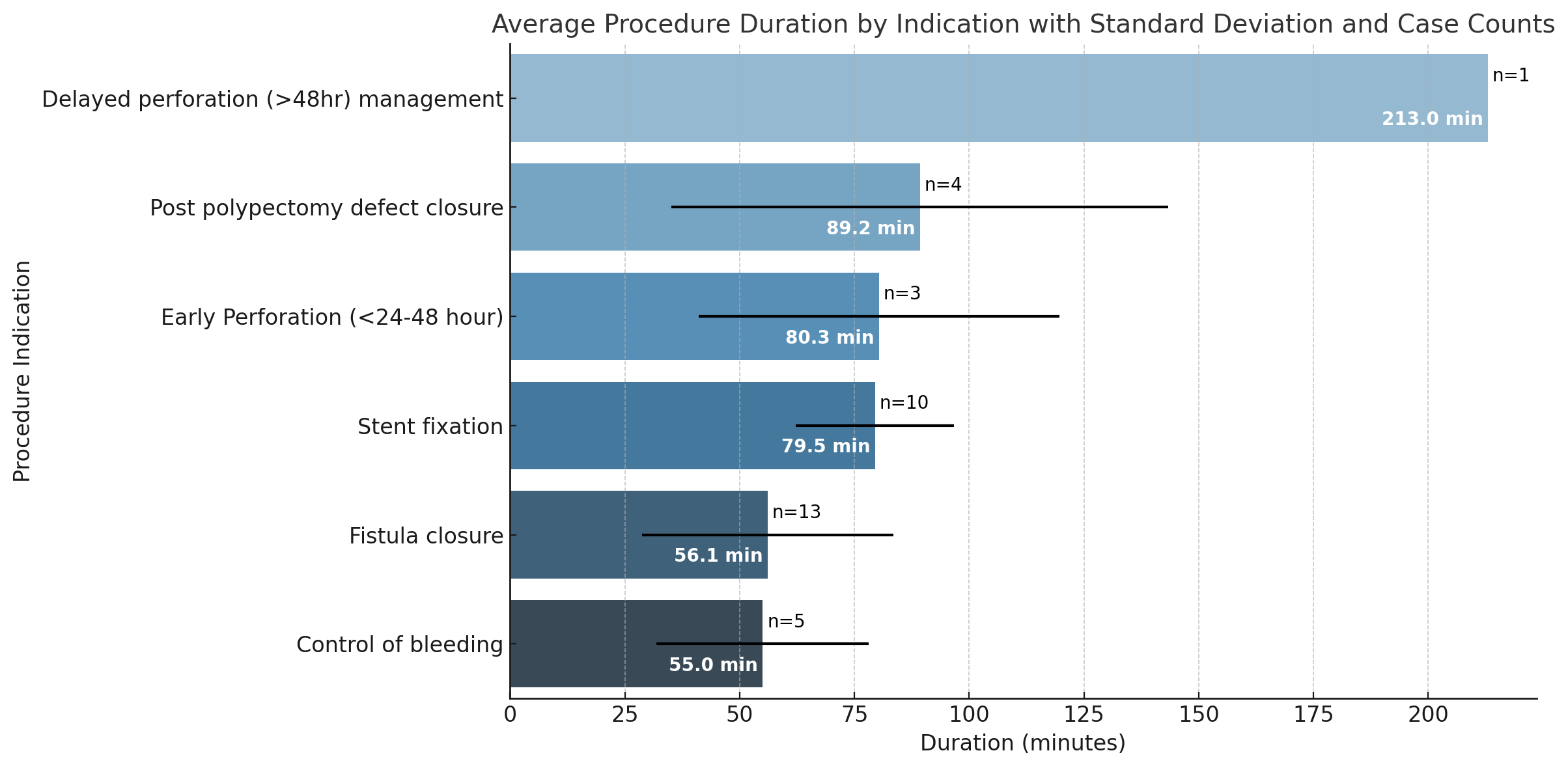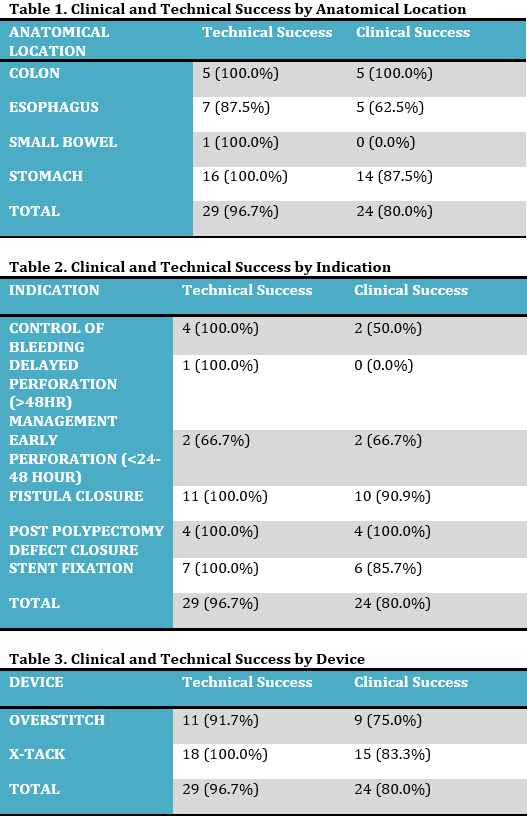Sunday Poster Session
Category: Interventional Endoscopy
P1419 - Efficacy and Safety of Endoscopic Suturing by Early-Career Gastroenterologists: A Retrospective Analysis
Sunday, October 26, 2025
3:30 PM - 7:00 PM PDT
Location: Exhibit Hall

Layth Alzubaidy, MD
UT Health Science Center-Tyler
Tyler, TX
Presenting Author(s)
Award: ACG Presidential Poster Award
Layth Alzubaidy, MD1, Sufiyan Kamal, MD2, Muhammad Majeed, MD2
1UT Health Science Center-Tyler, Tyler, TX; 2University of Texas Health East Texas Physicians, Tyler, TX
Introduction: Endoscopic suturing is an evolving treatment modality for gastrointestinal (GI) defect closure and stent fixation. While established among experienced endoscopists, limited data exist regarding its use by early-career gastroenterologists. We aimed to evaluate the technical and clinical outcomes, safety, and procedural characteristics of endoscopic suturing performed by early-career gastroenterologists.
Methods: We conducted a retrospective study of patients undergoing endoscopic suturing by three early-career Gastroenterology physicians (≤1.5 years post-fellowship). Data collected included demographics, indication, anatomical site, procedural duration, device used (OverStitch or X-tack), complications, and outcomes. Technical success was evaluated by the proper placement of sutures, while clinical success was studied by the resolution of the specific clinical issue without requiring reintervention in 4 weeks. Procedure time was defined as the duration from the start to the end of anesthesia.
Results: Thirty patients (mean age 64.4 ± 13.5 years; 46.7% male) were included. Common indications included fistula closure (36.7%), stent fixation (23.3%), post-polypectomy defect closure (13.3%), perforation management (13.3%), and bleeding control (13.3%). Overall technical success was 96.7% (29/30), and clinical success was 80.0% (24/30). No immediate complications occurred. By anatomical site, clinical success was highest in the colon (100%) and stomach (87.5%), and lowest in the esophagus (62.5%) and small bowel (0%). Clinical success by device was 75.0% for OverStitch and 83.3% for X-tack. Procedural duration averaged 75.2 ± 41.6 minutes. Multivariable regression did not reveal significant predictors of clinical success or shorter procedure time.
Discussion: Endoscopic suturing offers a minimally invasive alternative for patients who would have previously required surgical intervention, thereby reducing the associated morbidity. Adaptation of endoscopic suturing performed by early-career gastroenterologists is safe and effective. These findings support the early training and adoption of suturing techniques for gastroenterology practices.

Figure: Tables 1-3: Clinical and Technical Success Rates Stratified by Anatomical Location, Indication, and Device Used

Figure: Figure 1: Average Procedure Duration by Indication With Standard Deviation and Case Counts
Disclosures:
Layth Alzubaidy indicated no relevant financial relationships.
Sufiyan Kamal indicated no relevant financial relationships.
Muhammad Majeed indicated no relevant financial relationships.
Layth Alzubaidy, MD1, Sufiyan Kamal, MD2, Muhammad Majeed, MD2. P1419 - Efficacy and Safety of Endoscopic Suturing by Early-Career Gastroenterologists: A Retrospective Analysis, ACG 2025 Annual Scientific Meeting Abstracts. Phoenix, AZ: American College of Gastroenterology.
Layth Alzubaidy, MD1, Sufiyan Kamal, MD2, Muhammad Majeed, MD2
1UT Health Science Center-Tyler, Tyler, TX; 2University of Texas Health East Texas Physicians, Tyler, TX
Introduction: Endoscopic suturing is an evolving treatment modality for gastrointestinal (GI) defect closure and stent fixation. While established among experienced endoscopists, limited data exist regarding its use by early-career gastroenterologists. We aimed to evaluate the technical and clinical outcomes, safety, and procedural characteristics of endoscopic suturing performed by early-career gastroenterologists.
Methods: We conducted a retrospective study of patients undergoing endoscopic suturing by three early-career Gastroenterology physicians (≤1.5 years post-fellowship). Data collected included demographics, indication, anatomical site, procedural duration, device used (OverStitch or X-tack), complications, and outcomes. Technical success was evaluated by the proper placement of sutures, while clinical success was studied by the resolution of the specific clinical issue without requiring reintervention in 4 weeks. Procedure time was defined as the duration from the start to the end of anesthesia.
Results: Thirty patients (mean age 64.4 ± 13.5 years; 46.7% male) were included. Common indications included fistula closure (36.7%), stent fixation (23.3%), post-polypectomy defect closure (13.3%), perforation management (13.3%), and bleeding control (13.3%). Overall technical success was 96.7% (29/30), and clinical success was 80.0% (24/30). No immediate complications occurred. By anatomical site, clinical success was highest in the colon (100%) and stomach (87.5%), and lowest in the esophagus (62.5%) and small bowel (0%). Clinical success by device was 75.0% for OverStitch and 83.3% for X-tack. Procedural duration averaged 75.2 ± 41.6 minutes. Multivariable regression did not reveal significant predictors of clinical success or shorter procedure time.
Discussion: Endoscopic suturing offers a minimally invasive alternative for patients who would have previously required surgical intervention, thereby reducing the associated morbidity. Adaptation of endoscopic suturing performed by early-career gastroenterologists is safe and effective. These findings support the early training and adoption of suturing techniques for gastroenterology practices.

Figure: Tables 1-3: Clinical and Technical Success Rates Stratified by Anatomical Location, Indication, and Device Used

Figure: Figure 1: Average Procedure Duration by Indication With Standard Deviation and Case Counts
Disclosures:
Layth Alzubaidy indicated no relevant financial relationships.
Sufiyan Kamal indicated no relevant financial relationships.
Muhammad Majeed indicated no relevant financial relationships.
Layth Alzubaidy, MD1, Sufiyan Kamal, MD2, Muhammad Majeed, MD2. P1419 - Efficacy and Safety of Endoscopic Suturing by Early-Career Gastroenterologists: A Retrospective Analysis, ACG 2025 Annual Scientific Meeting Abstracts. Phoenix, AZ: American College of Gastroenterology.

